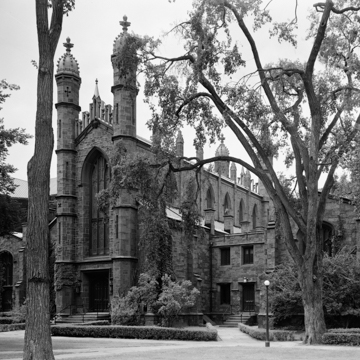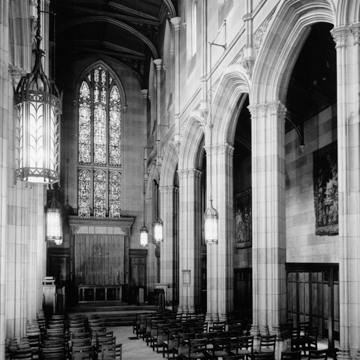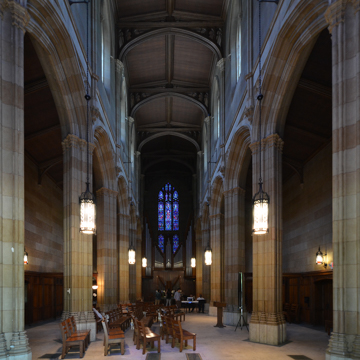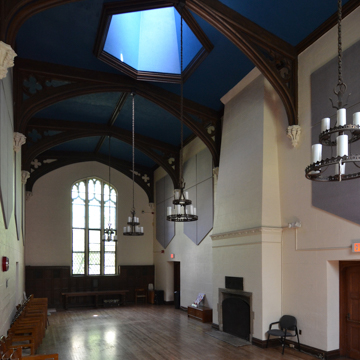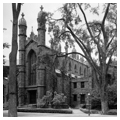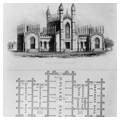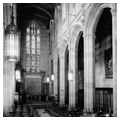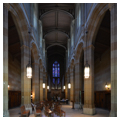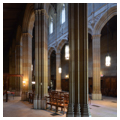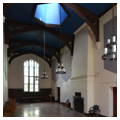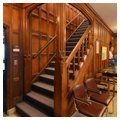You are here
Dwight Hall
Designed to house the growing book collection of Yale College and the collections of three undergraduate literary societies (Linonian, Brothers in Unity, and Calliope), the former Yale College Library, now Dwight Hall, represents a significant shift in Yale’s campus architecture. The building’s location adjacent to the Old Brick Row and its Gothic Revival style differ significantly from the architecture and planning of the College’s early development. The library was also an important commission in the early career of Henry Austin. At the same time, recent scholarship has illustrated the key roles played by Alexander Jackson Davis and Ithiel Town in the design of the building, pointing to an important period of collaboration between three of the most influential architects in mid-nineteenth-century America.
Constructed of brownstone from Portland, Connecticut, the building is composed of a central block with two smaller flanking blocks on either side connected by smaller linking spaces. The central hall is a large open area with smaller alcoves along each side, providing shelving for the book collection. This nave and side aisle composition gives the space what architectural historian James O’Gorman calls an “ecclesiastical cross section.” From the exterior, the library certainly appears church-like: two octagonal towers with domed copper roofs rise on the facade; a large, pointed arch window extends above the doorway; and each of the interior alcoves is marked on the exterior by a large, pointed arch window. Featuring many elements typical of Tudor Gothic architecture, the detailing nonetheless remains somewhat plain and restrained. The interior of the library features wooden doors and wood paneling with Gothic detailing. The original windows for the main hall were simpler than they are today, as the leaded stained glass windows with Gothic tracery were a later addition. The danger of fire was a major concern at the time of the building’s construction and the building featured many “fireproofing” elements, including its brownstone construction, tin roofs, and brick-vaulted basement ceilings. The five halls are also separated by load-bearing masonry firewalls, which kept internal access to a minimum.
Construction began in spring 1842, when stone began arriving on the site. At that time, according to existing documentation, Town and Davis’s involvement ends and Henry Austin becomes the project’s principal designer. In December 1843, Austin and Davis published a drawing in the Yale Literary Magazine, depicting the front elevation and a plan of the library. The plan shows the division of the interior into five spaces (from left to right): Linonian, Calliopean and College halls, a reading room, and Brothers Hall. The central College Hall was significantly larger than the secondary and the tertiary spaces, each of which was separated internally by thick masonry walls and had its own exterior access. The elevation depicts the form of the library as built, but with fewer Gothic details. In the executed design the linkages are not crenelated and the pinnacles along the rooflines are not nearly as tall or decorated (though a note at the bottom of the page indicates that “the engraver has unduly elongated the pinnacles”).
Origins of the commission are somewhat unclear. Some have claimed Austin was the sole designer but, as O’Gorman has noted, extant drawings point to the important role A. J. Davis played in the development of the design. Some of the difficulty in the attribution lies in the development of the commission for a dedicated library at Yale. In 1835, Yale alum Aaron N. Skinner requested a plan for a new library from Davis, who had designed a house for Skinner in New Haven a few years earlier. Davis’s scheme was a classical pantheon, inspired by Thomas Jefferson’s design for the Rotunda at the University of Virginia. Yale requested a more traditional arrangement of a rectangular space lined with book alcoves, which was the standard spatial arrangement for libraries at the time. Town and Davis completed a revised design (preserved in drawings at the Connecticut Historical Society Museum in Hartford) with a single block form similar to the design of King’s College Chapel in Cambridge, England, which consists of a central hall with alcoves running along each side. This design is remarkably similar to the central block of the executed library, but it does not depict the flanking halls or linkages that would ultimately be added to house the collections of the three student literary societies.
Austin and Davis’s design as constructed was a significant departure from Yale’s eighteenth-century Old Brick Row. By moving away from the New Haven Green, it set the stage for the adoption of the quadrangle plan in the 1870s and the redevelopment of the Old Brick Row with new Victorian Gothic buildings. Together with the Tudor castellated design of the Wadsworth Atheneum in Hartford (1842-1844), the library is one of two commissions that were jointly design by Austin with Town and Davis. It also marks Austin’s first major non-domestic commission after moving his practice to New Haven in 1841. Austin would go on to numerous important structures in New Haven including the Grove Street Cemetery Gate, the no-longer extant New Haven Railroad Station (1848–1849), the First Methodist Church (1849), and the New Haven City Hall (1860).
Over time, the library’s collections were moved into new buildings (Street Hall and the Peabody Museum). With the completion of the Sterling Memorial Library in 1930, it ceased operation as a repository. The library was converted into Yale’s YMCA in 1930–1931 by architect Charles Z. Klauder. At this time, the central hall was reconfigured into Dwight Memorial Chapel, and assembly rooms, a library, and the offices for the organization were created from the other spaces in the building. It was named Dwight Hall after Timothy Dwight (eighth president of Yale) and his grandson, Timothy Dwight (twelfth president of Yale). Today, the Center for Public Service and Social Justice operates in the building as an independent, nonprofit umbrella organization providing resources for student-run organization. The building also houses the University Chaplain’s Office.
References
“Dwight Hall at Yale: Center for Public Service and Social Justice.” Dwight Hall at Yale.Accessed February 2015. www.dwighthall.org.
“Dwight Hall (Old Library), 1842-46, Henry Austin (1804-1891).” Architecture of Yale.Accessed February 2015. www.yale.edu.
Kelley, Brooks Mather. Yale: A History.New Haven: Yale University Press, 1999.
Little, Geoffrey, ed. Yale Library Studies, Volume 1: Library Architecture at Yale.New Haven: Yale University Library, 2010.
O’Gorman, James F. Henry Austin: In Every Variety of Architectural Style.Middletown, CT: Wesleyan University Press, 2008.
Pinnell, Patrick L. Yale University Campus Guide. 2nd ed. New York: Princeton Architectural Press, 2012.
Roth, Leland M. American Architecture: A History.New York: Westview Press, 2003.
Writing Credits
If SAH Archipedia has been useful to you, please consider supporting it.
SAH Archipedia tells the story of the United States through its buildings, landscapes, and cities. This freely available resource empowers the public with authoritative knowledge that deepens their understanding and appreciation of the built environment. But the Society of Architectural Historians, which created SAH Archipedia with University of Virginia Press, needs your support to maintain the high-caliber research, writing, photography, cartography, editing, design, and programming that make SAH Archipedia a trusted online resource available to all who value the history of place, heritage tourism, and learning.














